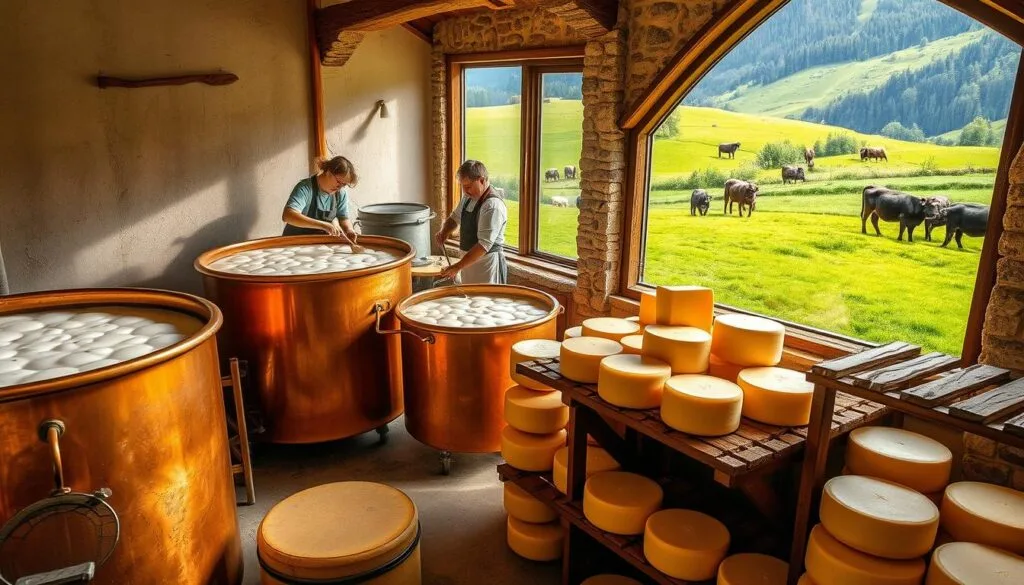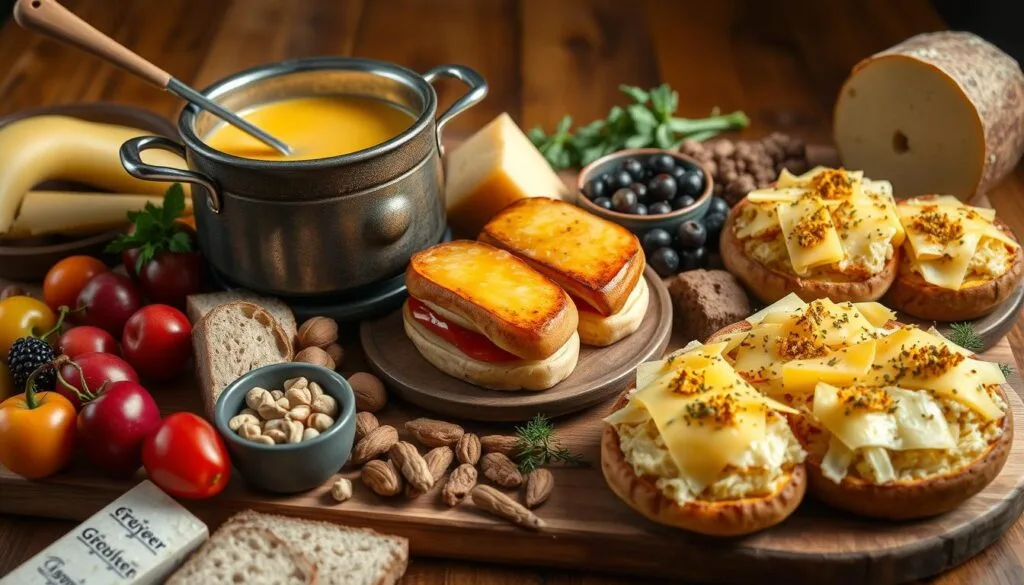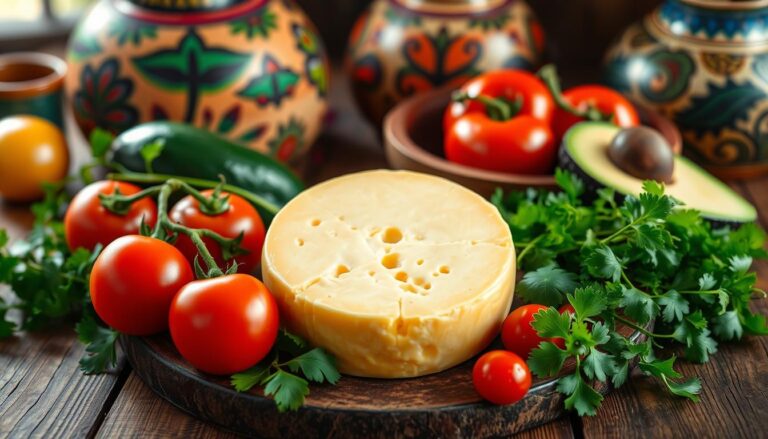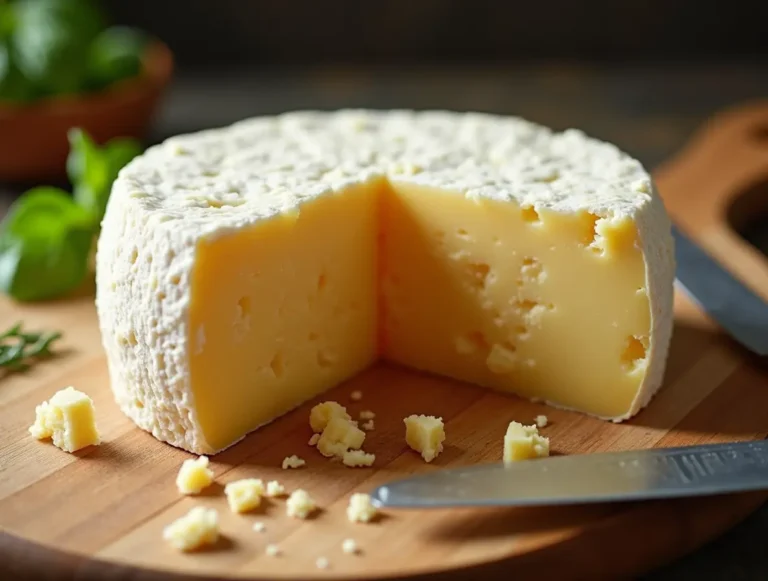Gruyere Cheese: A Swiss Delight Favorite Since 1115
I love cheese, and Gruyere from Switzerland is a favorite. Its creamy texture and nutty taste make it perfect for many dishes. It’s a key ingredient in fondues and gratins, adding a special touch.
If you enjoy food as much as I do, get ready for a tasty adventure. We’ll explore Gruyere cheese together. Its rich flavors and versatility make it a must-try for any food lover.
Table of Contents
What is Gruyere Cheese?
A Nutty and Creamy Swiss Delicacy
Gruyère is a semi-hard cheese made from cow’s milk. It’s known for its nutty and slightly funky taste. This cheese comes from Gruyères in southern Switzerland, with a history dating back to the 12th century.
It’s a semi-hard cheese with a firm texture. As it ages, the texture becomes grainier. Gruyère’s flavor is a mix of sweet, salty, and nutty notes. As it matures, its taste gets more complex, sometimes with earthy or spicy hints.
| Gruyere Cheese Characteristics | Details |
|---|---|
| Milk Type | Cow’s milk (unpasteurized) |
| Origin | Gruyères, Switzerland |
| Texture | Firm, becoming grainier with age |
| Flavor | Sweet, slightly salty, nutty, earthy, spicy |
| Aging Period | 3 to 6 months, sometimes longer |
Gruyère cheese is often compared to other Swiss cheeses like Beaufort and Comté. But its unique terroir and traditional making methods make it stand out. It has a distinct character that’s different from others.
The Origins of Gruyere Cheese
Gruyere cheese, a Swiss favorite, comes from western Switzerland’s beautiful landscapes. It was born in the Swiss cantons of Fribourg, Vaud, Neuchâtel, Jura, and Berne. The cheese is named after the town of Gruyère in Fribourg.
The story of Gruyere cheese goes back to the 12th century. It has a tradition over 900 years old. The Swiss AOC label protects it, making sure only cheese from the right region and made the right way can be called “Gruyere.”
The area around Gruyère is known for its green meadows and dairy history. This has been the heart of Gruyere cheese making for centuries. Every step in making Gruyere shows a dedication to quality and tradition.
“Gruyère cheese has been produced since 1115 in the area surrounding the village of Gruyère in Switzerland.”
The roots of where is gruyere cheese from go back to the 12th century. The history of gruyere cheese is tied to western Switzerland’s dairy traditions. This Swiss cheese, known for its unique taste and quality, is loved by cheese lovers worldwide.
Gruyere Cheese: A Swiss Geographical Indication
Gruyère cheese is more than just a Swiss treat. It’s a cheese with a special geographical mark. In 2001, Switzerland named “Gruyère” a Protected Designation of Origin (PDO). The European Union (EU) did the same in 2011. Its unique taste and quality come from its roots in the Gruyère region of Switzerland.
Understanding the Appellation System
The appellation system protects Gruyère cheese’s integrity. To be true Gruyère, it must be made in the Gruyère region. It uses traditional methods and ingredients. This keeps its famous nutty, creamy, and slightly grainy texture.
The cheese must age for at least five months. This aging process makes its flavor more complex. Cheeses aged longer get even more intense flavors, making them special.
“The protection of the GI ‘Gruyère’ in New Zealand aligns with the Free Trade Agreement (FTA) between New Zealand and the European Union, recognizing ‘Gruyère’ as a GI for cheese from France.”
The swiss geographical indication and gruyere cheese appellation systems keep Gruyère cheese authentic and high-quality. They protect its origins and traditional making methods. This helps keep Gruyère cheese’s unique identity and heritage alive for future generations.
The Art of Gruyere Cheese Making
Gruyère cheese is a true masterpiece, made with care and skill passed down through generations. The gruyere cheese making process shows the artistry in every wheel. From the milk selection to the aging, each step is crucial for its unique flavor and texture.
Traditional Methods and Expert Artisanship
The traditional gruyere cheese production starts with milk from cows within 12 miles of the creameries. This ensures the milk is fresh and local. The milk is then turned into cheese through a centuries-old process.
The wheels are salted in baths that are up to 85 years old. The water is never changed, adding to the flavor. The aging process is a labor of love, with wheels maturing for at least 5 months, and up to 24 months.
This long aging allows the cheese to develop its unique taste. Visitors to the Gruyère region can see this process up close. They gain a deeper appreciation for the art of Gruyère cheese making.
| Statistic | Value |
|---|---|
| Gruyère cheese production per year | 230 tonnes |
| Milk processed into Gruyère AOP annually | 2.7 million kilos |
| Cheese cave storage spaces available | 4,000 |
| Milk producers in Sonvilier | 8 |
| Additional accredited milk producers | 21 |
The commitment to traditional methods and expert artisanship makes Gruyère cheese special. It offers a unique dining experience for cheese lovers worldwide.

Gruyere Cheese Flavor Profile
Gruyere cheese has a complex and captivating flavor. It combines nuttiness, fruitiness, and sweetness. The gruyere cheese taste is a harmonious blend that excites the taste buds.
The texture of gruyere cheese is rich and creamy. It melts beautifully when heated. Younger gruyere is smooth, while aged varieties are firmer and grainier.
The aging process greatly affects gruyere’s flavor. Younger gruyere, aged for six months, is milder and sweeter. Aged gruyere, cured for a year or more, has a robust nutty flavor.
“Gruyère cheese is a true delight for the senses, with its captivating aroma, delectable taste, and luxurious texture. It’s no wonder it’s a beloved staple in the world of fine cheeses.”
Gruyere cheese’s unique taste makes it a favorite among cheese lovers. It’s great on its own or in various dishes. Gruyere cheese adds flavor to any meal.
Culinary Uses of Gruyere Cheese
Gruyere cheese is a Swiss delight that shines in many dishes. It melts well, making it perfect for grilled cheese sandwiches. Its nutty, creamy flavor complements crisp bread beautifully. It also adds luxury to cheesy pasta dishes like mac and cheese and pasta bakes.
Gruyere cheese is not just for savory dishes. It’s also great in baked goods like quiches and gratins. It brings a rich flavor to these dishes. Plus, it pairs well with fruits, bread, and even chocolate, showing its versatility.
From Fondues to Gratins and Beyond
Gruyere cheese is perfect for a classic Swiss fondue. It melts well, blending smoothly with white wine or kirsch. This makes it a great choice for a communal dish. It also shines in gratins, adding a special touch to potatoes, vegetables, and meat.
Looking to make a simple grilled cheese better or a baked dish more impressive? Gruyere cheese is your answer. It can transform your favorite recipes into something amazing.

Gruyere Cheese Pairing Suggestions
Gruyere cheese is a Swiss delicacy known for its versatility and flavor. It pairs well with many things, from white wines to fruits and cured meats. Finding the right pairings can make your meals even better.
White wine lovers will enjoy Gruyere with a Riesling or Chardonnay. The cheese’s nutty and creamy taste goes well with the wine’s fruity and aromatic notes. This makes for a perfect balance.
For those who like stronger flavors, Gruyere is great with fruit-forward reds. A Zinfandel and Syrah-based Farmhouse California Red is a perfect match. The cheese’s complex taste contrasts well with the wine’s bold fruitiness.
| Wine Pairing | Wine Characteristics | Gruyere Cheese Compatibility |
|---|---|---|
| Riesling | Fruity, aromatic, medium-bodied | Excellent |
| Chardonnay | Medium-bodied, creamy, oaked | Excellent |
| Farmhouse California Red Blend | Zinfandel and Syrah-based, fruit-forward | Excellent |
| Rosé | Fruit-forward, medium-bodied | Very Good |
| Pinot Noir | Lighter-bodied, elegant, fruit-driven | Very Good |
Gruyere cheese also goes well with other foods. Try it with fresh apples or juicy pears for a sweet contrast. Cured meats like prosciutto or salami add a savory touch, making the pairing even better.
Whether you’re hosting a party or just relaxing at home, exploring Gruyere cheese pairings is a fun journey. Let your taste buds lead the way as you find the perfect matches for this Swiss cheese.
Gruyere Cheese: A Versatile Ingredient
Gruyere cheese is great in the kitchen because it melts well. It’s perfect for making creamy dishes like fondues and pasta. Its flavor is complex, making it good for many dishes, from sandwiches to baked goods.
Elevating Dishes with Its Melting Qualities
Gruyere cheese melts beautifully. This is because it’s made with rennet, unlike cheeses made with acid. Younger Gruyere cheese melts best because it’s moist and has a good fat-to-water ratio.
When melted, Gruyere cheese is creamy and smooth. It’s perfect for fondues, gratins, and mac and cheese. Its nutty taste also works well in many dishes, from savory to sweet.
| Dish | How to Use Gruyere Cheese |
|---|---|
| Fondue | Gruyere cheese is a classic choice for fondue, melting seamlessly into the dish and providing a rich, creamy texture. |
| Gratin | Gruyere cheese’s melting properties make it an excellent topping for gratins, adding a golden, bubbly crust. |
| Mac and Cheese | Gruyere cheese can be used in mac and cheese recipes, blending with other cheeses to create a luxurious, velvety sauce. |
Using Gruyere cheese can make many dishes better. It adds flavor and creaminess to both savory and sweet dishes. This makes for delicious, indulgent meals.
Substitutes for Gruyere Cheese
Gruyere cheese is a Swiss delight known for its unique flavor. But, there are other cheeses that can replace it in recipes. These gruyere cheese substitutes and alternatives to gruyere cheese taste and melt like Gruyere. They’re great for many dishes.
Some top substitutes for Gruyere cheese are:
- Swiss Cheese: Swiss cheese has a nutty and sweet taste. It’s perfect for fondue and mac and cheese.
- Emmental Cheese: Emmental cheese tastes mild and nutty, like Gruyere. It melts well, making it a good choice.
- Appenzeller Cheese: From Switzerland, Appenzeller cheese has a strong and tangy flavor. It adds depth to dishes that use Gruyere.
- Comté Cheese: Comté, a French cheese, tastes sweeter and fruitier than Gruyere. It’s a tasty alternative in recipes.
Other cheeses like Gouda, Fontina, and Jarlsberg can also substitute for Gruyere. Each has its own taste and melting properties. Choose one based on the dish and flavor you want.
Using any of these substitutes, you can still enjoy the rich, nutty, and creamy taste of Gruyere in your favorite dishes.
Pronunciation Guide for “Gruyere Cheese”
Gruyere cheese is a Swiss favorite, but many find its pronunciation tricky. Let’s learn how to say “Gruyere” correctly.
The right way to say “Gruyere” is “groo-yair” or “groo-yehr”. The “u” sounds like the “oo” in “food”. The stress falls on the second syllable.
Knowing how to say Gruyere can impress cheese lovers. It shows you care about the details of food. This small skill can make your conversations about cheese more interesting.
Here are some tips to practice:
- Break the word into “Groo” and “yair” or “Groo” and “yehr”.
- Focus on the second syllable, “yair” or “yehr”, while keeping the “oo” sound in the first syllable.
- Listen to how “Gruyere cheese” is pronounced to improve your own.
With a bit of practice, you’ll say Gruyere like a pro. Show off your cheese knowledge to your friends and family!
Conclusion
Gruyere cheese is a Swiss delicacy loved by many worldwide. It has a rich history and a complex flavor. This cheese is versatile and continues to delight and inspire.
Enjoy Gruyere on its own or in classic dishes. It’s a must-try for cheese lovers. From its origins to its European AOC designation, it shows Swiss cheesemaking’s artistry and tradition.
Start your gruyere cheese overview and explore its unique qualities. Discover its rich history and nuanced flavors. Gruyere cheese is a culinary gem that deserves to be celebrated and shared.
FAQ
What is Gruyere cheese?
Gruyere cheese is a semi-hard cheese from Switzerland. It’s made from raw cow’s milk and aged for 3 to 10 months. It’s known for its creamy texture and nutty flavor.
Where does Gruyere cheese come from?
It comes from Swiss cantons like Fribourg, Vaud, Neuchâtel, Jura, and Berne. It’s named after the town of Gruyère in Fribourg.
What is the flavor and texture of Gruyere cheese?
Gruyere cheese has a complex flavor. It’s nutty with hints of fruit and sweetness. Its texture is creamy, becoming more supple and slightly crumbly with age.
How is Gruyere cheese made?
Skilled artisans make Gruyere cheese with precision. The aging process happens in caves or cellars. The cheese is turned regularly for even maturation.
What are the culinary uses of Gruyere cheese?
Gruyere cheese is versatile. It’s great for grilled cheese, cheesy pasta, quiches, gratins, and potato au gratin. Its melting properties are remarkable.
What are some good substitutes for Gruyere cheese?
Good substitutes include Swiss, Emmental, Appenzeller, and Comté cheese. They have similar flavors and melting properties.
How do you pronounce “Gruyere” cheese?
Pronounce it as “groo-yair” or “groo-yehr” (ɡruːˈjɛər/). The “u” sounds like the “oo” in “food.” Emphasize the second syllable.








6 Comments
Comments are closed.